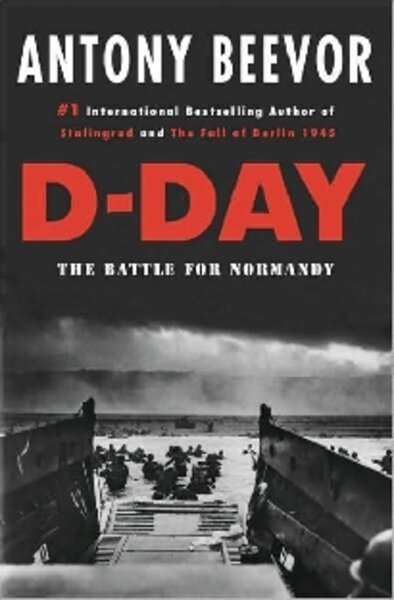D-Day: The Battle for Normandy
Loading...
After countless books and movies, it’s hard to imagine that there is much left to write about the D-Day invasion of German-occupied France in June 1944. But as Antony Beevor demonstrates in D-Day: The Battle for Normandy, our knowledge of this military campaign – like any part of history that becomes very familiar – benefits considerably from fresh eyes and exhaustive research.
Beevor argues that the D-Day invasion must be seen as part of a much larger campaign. The invasion itself is only the first part of the story. It was what happened after D-Day, in the brutal fighting among the hedgerows and small towns of Normandy, that ultimately enabled the Allies to push the Germans out of France. This broader and longer struggle, from the invasion to the liberation of Paris, is the subject of this extensively researched, well-written, and insightful volume.
Beevor is one of the most influential and prolific military historians currently writing about World War II. His books are characterized by exhaustive research, careful analysis of the strategic and tactical decisions on all sides, an emphasis on the fighting as experienced by front-line soldiers, and an unrivaled ability to convey in clear language the horror of warfare.
He tells the story of the Normandy campaign chronologically beginning with the mobilization of the men and materiel in Britain. This is followed by four separate chapters that analyze the invasion beaches and a fifth that summarizes the effort to secure them. The remainder of the book examines what it took for the Allies to break out of Normandy and to liberate Paris at the end of August. Individual chapters are devoted to major aspects of the campaign such as Caen, Villers-Bocage, the Cotentin Peninsula, Saint-Lô, and the Falaise pocket.
Beevor clearly admires some of the military leaders on both sides, such as Dwight Eisenhower and Erwin Rommel. Among the Americans, Omar Bradley is portrayed as solid and careful while George Patton, the allied general the Germans most feared, is vain, aggressive, and extraordinarily effective. He also makes clear who he thinks fell short: British Gen. Bernard Montgomery comes across as pompous, self-serving, and ineffective.
The extensive analysis even includes the military hardware used by both sides. Beevor makes it clear that the Allies had nothing comparable to the German Tiger and Panther tanks or their MG 42 machine gun, and that superior equipment greatly aided the German defense. Indeed, British Cromwell tanks could not knock out their German counterparts, even at point-blank range. Both the Americans and British were “shaken” to realize that German equipment was superior, or, as one British officer wrote, “After four years of preparation for the invasion why are our machines so inferior?”
Like others who have written about D-Day, Beevor concludes that the Allies ultimately prevailed for several key reasons: The German commanders were subject to micromanagement by Hitler and his general staff, the Luftwaffe was nowhere to be seen, and British and American air power made it hard for the defenders to move troops and equipment, especially tanks, to the places they were most needed. Finally, the Allies enjoyed an enormous advantage in the number of men and the amount of equipment they were able to put ashore. One American observer, for example, noted that a week after the invasion, Omaha Beach “resembled Coney Island on a hot Sunday.”
The book differs from other D-Day histories in several key respects. First, Beevor quotes frequently and extensively from the diaries and letters of soldiers on both sides and this adds a great deal of nuance and texture to the story. Second, he devotes considerable attention to the horrors experienced by the French civilians who were caught in the war zone. Nobody knows exactly how many civilians perished in the Normandy campaign but the number must have been staggering. Beevor writes, “3,000 French civilians died in the first twenty-four hours of the invasion, double the total number of American dead.”
Finally, Beevor discusses the ferocity of the fighting and the carnage on the battlefield in more detail than most other historians. He makes a convincing case that – Russian arguments and popular wisdom to the contrary – the fighting in Normandy between D-Day and the liberation of Paris was at least as intense and savage as the warfare taking place on the Eastern front. [Editor's note: The review originally mistakenly referred to the Western front.]
Because this is a military history, there is an extensive analysis of what individual Army units were doing. This is unavoidable, but it will, at times, leave the general reader feeling a bit overwhelmed. Lay readers would also benefit if the brief glossary had been more complete. Moreover, the table showing comparative ranks of the American, German, and British armies should have been included in the book, rather than posted on a website.
But these are relatively minor quibbles. This is a superb book and a model of the historian’s craft. It stands as the best one-volume history of this decisive military engagement.
Terry Hartle is senior vice president of government relations for the American Council on Education.






